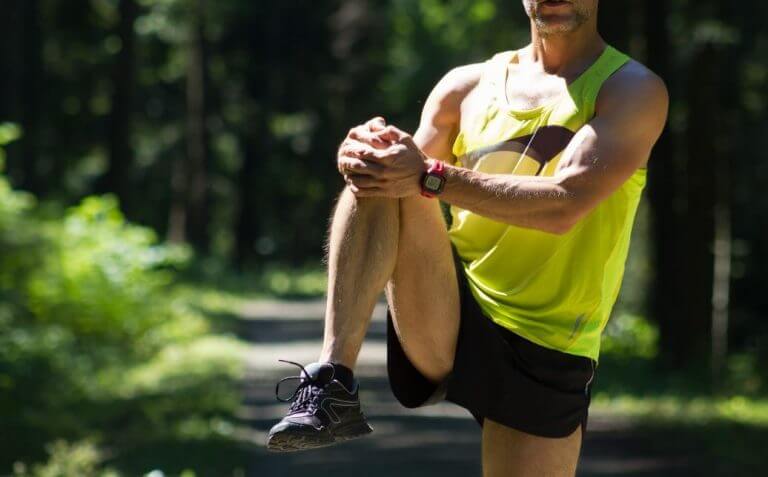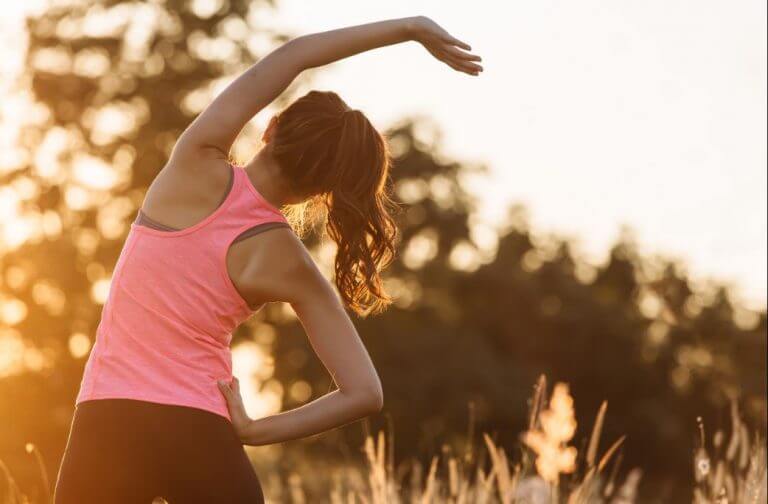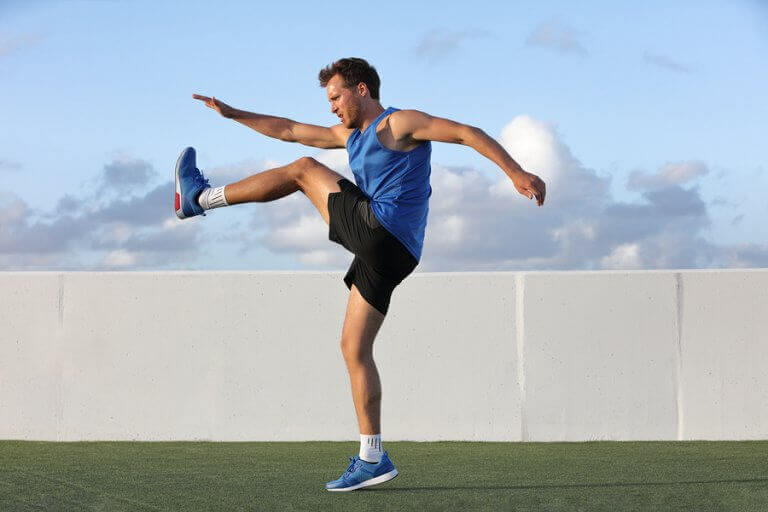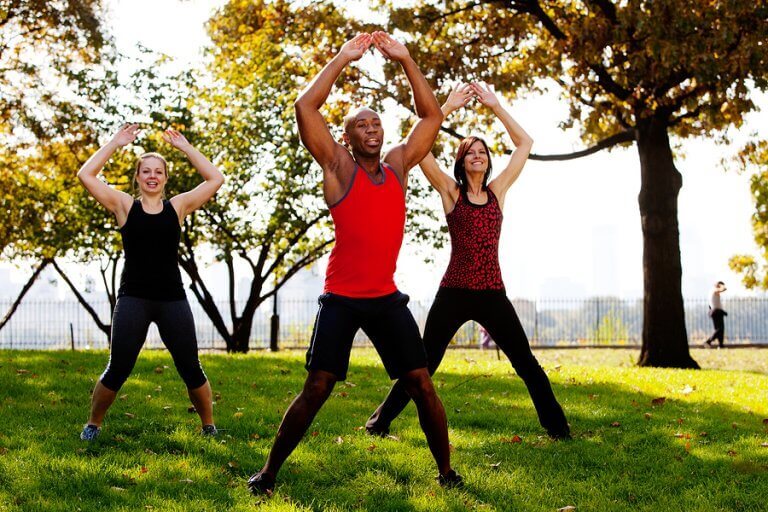Discover the Types of Warm-Up Exercises you can do at Home

Warm-up exercises are an essential stage in any type of training. Unfortunately, many people ignore and skip this part of their workouts. In the next article, we’ll discover all the types of warm-up exercises you can do at home so that you don’t lose a single second traveling to the gym. Take notes and incorporate them into your workout routine!
Warming up allows your body to activate and it prepares you to work out. The truth is that, unless you want to increase your risk of injury and negatively impact your performance, you absolutely need a good warm-up routine. This is even more important when you’re doing cardio without going to a gym.
As a matter of fact, you can stay fit by training outdoors and trying aerobic exercises such as running, riding a bike or skating. In these cases, the most important thing is to warm up at home. Next up, we’ll tell you which preparation movements you can perform in the comfort of your own home.
Types of warm-up exercises you can do at home
1. General warm-up
Do this warm-up routine during the first stage of your work out, with moderate intensity. The goal is to prepare your muscles for the next activity. Here are some examples:
- Head nods and shakes: this first exercise is perfect to warm-up your neck muscles. Start by nodding your head softly and then shaking it as if you were trying to say ‘no’. First one movement and then the other or vice versa.

- Lateral arm raises: to perform a lateral arm raise, lift both arms at the same time in a controlled movement. You only have to do 15-20 repetitions to finish this part of the warm-up.
2. Specific warm-up exercises
During a specific warm-up, you don’t activate all the joints in your body, only the ones that you’ll use for certain activities. These are some examples:
- Knee circles: this is an ideal movement for people who like to run outside. To do it, bend your knees slightly and move them in a circle to the right, keep your feet firmly on the ground. While it’s true that our knees receive a lot of impacts when we do athletic exercise, knee circles can help to strengthen them and stabilize our ankles.

- Arm circles: to perform this exercise, stretch your arms to your sides and keep your elbows facing down. Move your arms in a circle to the right, keeping them straight the whole time. After 10 circle movements, repeat everything but this time do it counterclockwise. Do smaller circles and then increase your speed and do bigger circles.

3. Dynamic warm-up exercises
The third type of warm-up combines elements such as flexibility, coordination, and balance. It consists of including dynamic stretches in the warm-up; the same movements that you’ll do in your training but with a milder intensity. These are some practical examples:
- Knee raises: this exercise is great for your hip flexors and quadriceps. It’s also the perfect movement for cardio exercises that require the use of your legs. If you want to do a knee raise, all you need is to lift one foot from the ground, until your knee is at least at your waist level. At that moment, pause for a couple of seconds and then put your foot back down. To end the movement, repeat the same steps with your other foot. You must do a total of 10 repetitions per leg. If you want to increase the difficulty, try lifting your knee up higher.

- Jump while opening and closing your legs: this exercise, also known as a jumping jack, is very simple. It consists of standing up with your arms an legs close together. Then, you must jump opening your arms and legs intermittently.

As you were able to see, there are many different types of warm-up exercises you must take into account when preparing your body to work out. Always remember to do them before your training sessions.
Also, don’t forget to stretch whenever you finish any kind of physical training session. Stretching and warming up are two of the most important parts of having a good performance and avoiding injuries.
Warm-up exercises are an essential stage in any type of training. Unfortunately, many people ignore and skip this part of their workouts. In the next article, we’ll discover all the types of warm-up exercises you can do at home so that you don’t lose a single second traveling to the gym. Take notes and incorporate them into your workout routine!
Warming up allows your body to activate and it prepares you to work out. The truth is that, unless you want to increase your risk of injury and negatively impact your performance, you absolutely need a good warm-up routine. This is even more important when you’re doing cardio without going to a gym.
As a matter of fact, you can stay fit by training outdoors and trying aerobic exercises such as running, riding a bike or skating. In these cases, the most important thing is to warm up at home. Next up, we’ll tell you which preparation movements you can perform in the comfort of your own home.
Types of warm-up exercises you can do at home
1. General warm-up
Do this warm-up routine during the first stage of your work out, with moderate intensity. The goal is to prepare your muscles for the next activity. Here are some examples:
- Head nods and shakes: this first exercise is perfect to warm-up your neck muscles. Start by nodding your head softly and then shaking it as if you were trying to say ‘no’. First one movement and then the other or vice versa.

- Lateral arm raises: to perform a lateral arm raise, lift both arms at the same time in a controlled movement. You only have to do 15-20 repetitions to finish this part of the warm-up.
2. Specific warm-up exercises
During a specific warm-up, you don’t activate all the joints in your body, only the ones that you’ll use for certain activities. These are some examples:
- Knee circles: this is an ideal movement for people who like to run outside. To do it, bend your knees slightly and move them in a circle to the right, keep your feet firmly on the ground. While it’s true that our knees receive a lot of impacts when we do athletic exercise, knee circles can help to strengthen them and stabilize our ankles.

- Arm circles: to perform this exercise, stretch your arms to your sides and keep your elbows facing down. Move your arms in a circle to the right, keeping them straight the whole time. After 10 circle movements, repeat everything but this time do it counterclockwise. Do smaller circles and then increase your speed and do bigger circles.

3. Dynamic warm-up exercises
The third type of warm-up combines elements such as flexibility, coordination, and balance. It consists of including dynamic stretches in the warm-up; the same movements that you’ll do in your training but with a milder intensity. These are some practical examples:
- Knee raises: this exercise is great for your hip flexors and quadriceps. It’s also the perfect movement for cardio exercises that require the use of your legs. If you want to do a knee raise, all you need is to lift one foot from the ground, until your knee is at least at your waist level. At that moment, pause for a couple of seconds and then put your foot back down. To end the movement, repeat the same steps with your other foot. You must do a total of 10 repetitions per leg. If you want to increase the difficulty, try lifting your knee up higher.

- Jump while opening and closing your legs: this exercise, also known as a jumping jack, is very simple. It consists of standing up with your arms an legs close together. Then, you must jump opening your arms and legs intermittently.

As you were able to see, there are many different types of warm-up exercises you must take into account when preparing your body to work out. Always remember to do them before your training sessions.
Also, don’t forget to stretch whenever you finish any kind of physical training session. Stretching and warming up are two of the most important parts of having a good performance and avoiding injuries.
All cited sources were thoroughly reviewed by our team to ensure their quality, reliability, currency, and validity. The bibliography of this article was considered reliable and of academic or scientific accuracy.
- Safran, M. R., Garrett, W. E., Seaber, A. V., Glisson, R. R., & Ribbeck, B. M. (1988). The role of warmup in muscular injury prevention. The American Journal of Sports Medicine, 16(2), 123–129. https://doi.org/10.1177/036354658801600206
-
Sánchez-Sánchez, J., Rodríguez-Fernández, A., Villa-Vicente, G., Petisco-Rodríguez, C., Ramírez-Campillo, R., & Gonzalo-Skok, O. (2017). Efecto de un calentamiento con estiramientos estáticos y dinámicos sobre el salto horizontal y la capacidad para repetir esprint con cambio de dirección. RICYDE: Revista Internacional de Ciencias Del Deporte, 13(47), 26–38. https://doi.org/10.5232/ricyde2017.04702
This text is provided for informational purposes only and does not replace consultation with a professional. If in doubt, consult your specialist.








